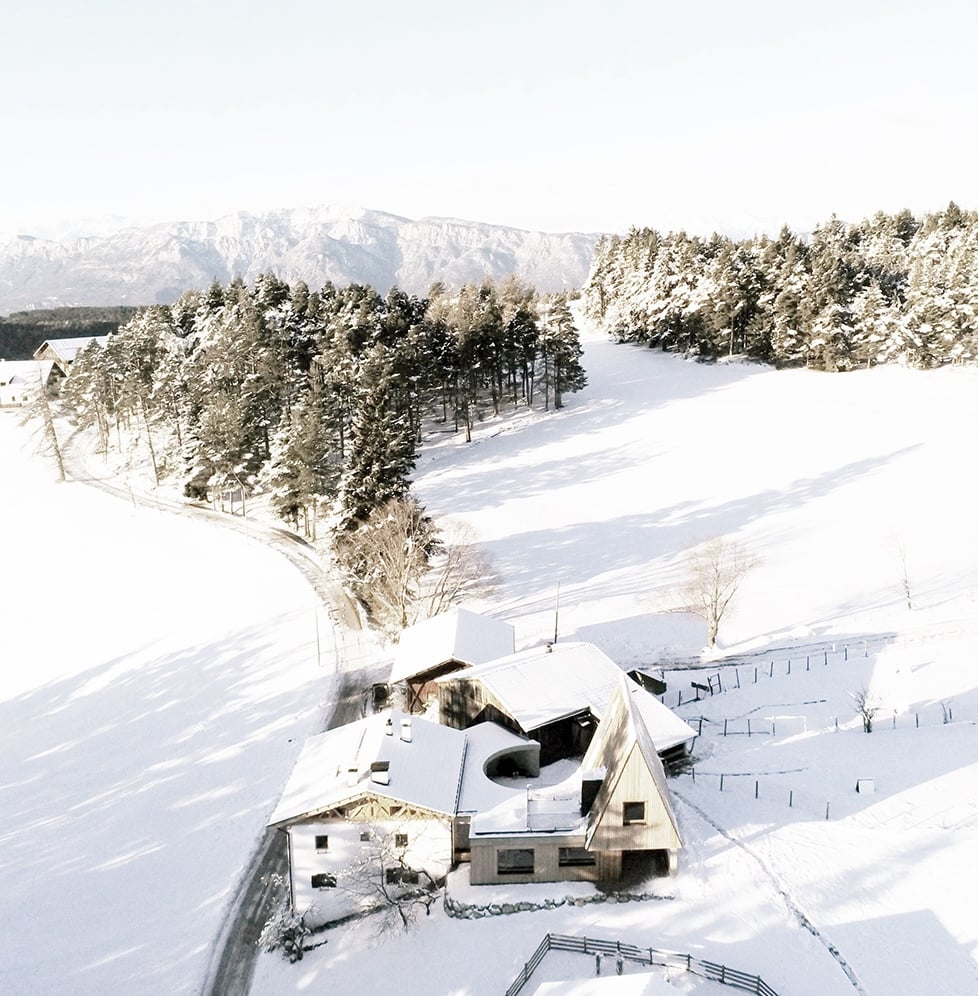Architects: Alpina Architects
Photographs: Alpina Architects, Simone Bossi
Category: Houses, Renovation, Extension
Design Team: Alpina Architects
Town: Nova Ponente
Country: Italy
BS Hof House, a residential extension designed by Alpina Architects in Nova Ponente, Italy, has transformed a 19th-century farmstead into a multi-generational dwelling that bridges tradition and autonomy through spatial and material continuity. Set at 1,300 meters above sea level in the province of Bolzano, the project addresses the client’s desire to remain rooted in her family farm while creating a separate yet connected living space. The intervention avoids vertical expansion, instead utilizing the sloped terrain to introduce a new timber volume at the upper floor level. A circular patio links the historic stone house to the new larch-clad addition, establishing both visual and functional transitions. Internally, the farmhouse’s original sleeping quarters become living spaces, while the new extension houses bedrooms and a master suite articulated through warm timber interiors. A concrete loggia projects from the patio to frame views of the Alpine landscape. Material strategy contrasts untreated timber with sandblasted concrete, integrating contemporary additions within the historical context. BS Hof House reinforces continuity between past and future by preserving the typological clarity and scale of the original farmstead.

Nova Ponente, a small town in the province of Bolzano, is located in the mountains at an altitude of 1,300 meters above sea level. With a population of approximately 4,000, it is also the birthplace and childhood home of the client, who grew up at BS Hof, the family farmstead, surrounded by animals and nature. Over time, she developed a clear need for a personal living space where she could eventually live with her own family. However, her strong desire to remain closely connected to the place and to continue participating in the daily life of the farm formed the foundation for the development of this project.



BS Hof was constructed in 1850, a date inscribed on the primary beam that supports the wooden roof and illustrated in the family crest painted above the entrance. Since its origin, the farmstead has operated in close connection with nature, sustained by the animals that inhabit it. Over time, several additional structures, including the barn and stables, were added around the main house, forming a compact group of buildings that create a distinctive village-within-a-village atmosphere. A key feature of traditional farmsteads like this one is the material contrast: the main house is built in stone and finished with plaster, while the secondary buildings are made of wood, establishing a clear visual hierarchy among the volumes. BS Hof maintains this typology. It is organized over three levels, carefully integrated into the sloped landscape. The lowest level contains the cellars, the first floor is used for communal living spaces such as the stube and kitchen, and the upper floor accommodates the bedrooms.

As the family expanded over time, a new requirement became apparent: the creation of a dedicated living space for the farmer’s daughter, enabling her to remain within the farmstead while retaining her independence. The original plan proposed dividing the house into two separate areas, with the parents continuing to live on the first floor and the second floor, along with a newly constructed attic, designated for the daughter. However, as the project progressed, the design evolved significantly beyond the clients’ initial expectations.



The project began with a detailed analysis of the existing farmhouse, its surrounding built environment, and the landscape to which it is closely connected. Initial design proposals followed the client’s suggestions, including plans to raise the roof in order to create more living space. However, it quickly became evident that this solution would distort the farmhouse’s proportions, diminishing its original character and inherent elegance. A different strategy was required—one that could meet the functional needs without compromising the integrity of the existing structure. After thorough research and a series of conceptual sketches, an alternative solution was developed. Instead of building upward, the design made use of the site’s natural slope to introduce a new volume at the level of the farmhouse’s upper floor, traditionally used as a sleeping area. This new structure, conceived as a precisely integrated extension, connects to the original house while forming a distinctly new element. It links internally to the second floor of the farmhouse and extends toward the north, maintaining a careful balance between continuity and independence. A circular patio is placed between the old and new volumes, serving as a transitional space. Within this assembly of interconnected forms, it became clear that the new residence required its own architectural identity, marking a new phase in the evolution of BS Hof. The resulting design features a bold triangular shape that references the archetype of a hut. Emerging clearly from the surrounding terrain, it asserts its presence within the landscape.

The design is based on a clear and focused concept: to expand the farmhouse by introducing a new volume adjacent to the existing structure while preserving the original building’s form, geometry, and proportions. In keeping with traditional construction methods, the extension develops horizontally rather than vertically, intentionally setting itself apart from the historic structure. A circular patio facilitates the transition between the old and the new, representing the connection between past and future. This central space serves as the core of the project, offering an enclosed yet open area that frames the surrounding landscape and opens to the sky within a perfect circle. The link between the original house and the extension is defined by a flat-roofed structure that accommodates the main entrance. Visitors move from the farmhouse’s historic entry through a stair set between two solid walls, arriving in the calm setting of the patio. From this point, an internal corridor organizes circulation, dividing the living areas from the sleeping quarters. Within the historic farmhouse, the former sleeping rooms are converted into living spaces, with all original openings carefully preserved. A central functional core is introduced, containing a stove, kitchen, pantry, and a staircase that leads to a mezzanine designed by Alpina Architects in the attic. At this upper level, gable ends that were previously closed are now glazed, allowing expansive views of the surrounding mountains to be framed from within the elevated interior.

The extension contains the more private functions of the home. A corridor leads to two bedrooms intended for the future children, while a staircase positioned at the far end ascends to the uppermost level, which forms the most distinctive part of the project. This level houses the master bedroom and en-suite bathroom, enclosed within a warm, continuous wooden interior that recalls the elemental comfort of a cabin. On the exterior, the circular patio becomes the central element of the composition. Extending from its edge, a concrete viewing frame projects toward the surrounding landscape and establishes a firm visual connection to the original farmhouse. This loggia terrace acts as a dedicated observation point, carefully oriented to capture panoramic views of the Alpine mountains. Through this specific architectural intervention, the project establishes its identity, assertive yet respectful, creating a balanced relationship between the historical context and contemporary addition. In this setting, the viewer is drawn into the surrounding environment, fully engaged with the Alpine landscape. Within this space, the architectural dialogue between past and future becomes tangible, offering a place for solitude, reflection, and continuity.

Material choices for the extension are strongly grounded in tradition. Timber is the primary material, used both for the structure and as exterior cladding. The new volume, defined by its pitched roof, is clad in untreated larch slats that will gradually weather to a silvery grey as they age naturally.

In contrast, the base of the structure, the flat-roofed connecting element, and the patio are built using sandblasted exposed concrete. This treatment gives the concrete a raw, textured appearance that recalls the look of natural stone by revealing the embedded porphyry aggregates. The resulting three-dimensional surface interacts with light in varied ways, bringing depth and character to the material.

Through its thoughtful selection of materials and its respectful yet confident architectural language, the project for BS Hof continues the narrative of the farmstead, honoring its past while actively shaping its future.

Project Gallery

































Project Location
Address: Nova Ponente, 39050 Deutschnofen, Autonomous Province of Bolzano – South Tyrol, Italy
Location is for general reference and may represent a city or country, not necessarily a precise address.


